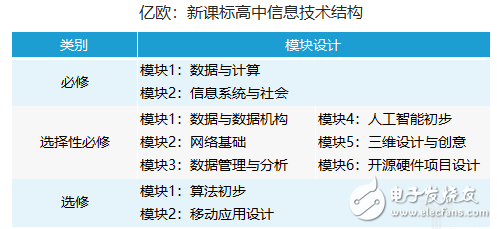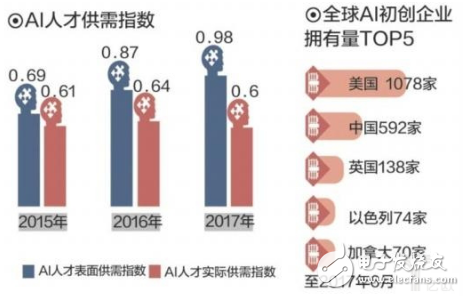China is determined to become an AI big country, but it is reported that the AI ​​talent gap has become one of the important issues hindering the development of the industry. Under the huge talent gap, the school's AI talent education is an indispensable link. To this end, the Ministry of Education held a press conference to express the demand for high school AI, which will be implemented this fall semester. In 1956, at a meeting held at Dartmouth College, computer expert John McCarthy proposed the term artificial intelligence, and artificial intelligence was born, and its life began to surge. The development of artificial intelligence is naturally inseparable from AI talents. In this regard, countries are turning their attention to AI education at the K12 (6-18 year olds) stage. In September 2013, the UK became the first country in the world to incorporate computer programming into compulsory school education. In 2016, the US government proposed the "People's Computer Science Education" program, announcing that it will invest 4 billion US dollars to carry out K12 programming education. In January of this year, the Ministry of Education of China also stated that AI, algorithms, open source hardware, etc. should enter the national high school new curriculum standard. High school students also want to learn AI. It seems that China's AI talent education is to start from the doll. On January 16 this year, the Ministry of Education held a press conference to introduce the new version of the curriculum. In the "new curriculum standard" reform, artificial intelligence, Internet of Things, big data processing, algorithms, and open source hardware project design were officially included in the new curriculum standard. This fall semester began to implement. In the revised version of the program, high school learning content is divided into compulsory courses, optional compulsory courses and elective courses. The high school information technology compulsory courses include two modules: “Data and Computing†and “Information Systems and Societyâ€. Among them, "data and calculation" proposed: understanding data coding, learning to collect; analyzing and visualizing data; learning a programming language, and using a programming language to complete a simple algorithm; understanding the importance of artificial intelligence. High school information technology selective compulsory courses are designed according to students' needs for further study and development, including “data and data structureâ€, “network foundationâ€, “data management and analysisâ€, “artificial intelligence preliminaryâ€, “three-dimensional design and creativity†and “open source hardware projectâ€. Design "six modules. The high school information technology elective courses include “analytic initialsâ€, “mobile application design†and information technology school-based courses offered by each high school. Among them, the general technology selective compulsory course is equipped with a robot design and production module, which consists of four parts: robot structure and transmission machinery, robot perception and propagation device, robot controller and robot control strategy. The content of the artificial intelligence part includes three parts: artificial intelligence foundation, simple artificial intelligence application module development and artificial intelligence technology development and application. In the teaching implementation, teachers use the situation simulation or real-life observation to let students experience the impact of artificial intelligence on social development, and win the championship in the quiz and image memory challenge by discussing artificial intelligence, defeating the top human chess player event. To guide students to understand the artificial intelligence technology. Compared with the 2003 version of the curriculum standard, the "new curriculum standard" has greatly reduced the requirements for basic software use, and greatly improved the thinking requirements in programming, computational thinking, algorithms, as well as artificial intelligence, open source hardware, cyberspace. Knowledge requirements such as safety. This reform can be said to be prepared in advance for the university to train programmers and AI talents. Although many contents related to artificial intelligence, Internet of Things, and big data processing have been added, artificial intelligence education for K12 (6-18 year olds) is not included in the practice of artificial intelligence education initiated by educational institutions at home and abroad. In the absolute sense of artificial intelligence courses, but more involved in a broader, more universal computer science. The ultimate goal of computer science courses should be to enhance students' computer thinking skills and better connect with university courses. In the past, science and information technology courses taught more basic software and scientific knowledge, and the curriculum was relatively simple. However, there was less attention to specialized programming knowledge and emerging technologies that were connected to the forefront of the times. The rapid development of artificial intelligence and other information science and technology has increasingly required the support of high-end talents. This requirement has gradually extended from the university to the high school section that is connected with the university. At the press conference of the new curriculum standard, Zheng Fuzhi, assistant to the Minister of Education and director of the textbook bureau, also said that the classification of such courses was set as the institutional arrangement for the 6th election of the new college entrance examination. The whole education and teaching involved in learning, teaching, examination, evaluation, etc. They will all be thoroughly opened and maintain a high degree of consistency. The optimization of the course structure is also to meet the needs of the college entrance examination. AI entered the high school curriculum standard and trained AI talents in advance for the university. This sounds gratifying, but under the attention, it is the huge AI talent gap facing China. Well-known economist Wu Xiaobo believes that although artificial intelligence is very hot at present, there are not enough AI talents, and everything is empty talk. Wang Di, vice president of technology at Global Workplace Platform, said that there are more than 1.9 million in-depth learning and data mining talents in the world, of which 850,000 are in the United States, only 50,000 in China, and 140,000 Chinese. As China continues to forge ahead in the field of artificial intelligence, the attractiveness of Chinese companies to talents is also rising, but it is still not easy to operate when HR recruits talents and how to recruit them. According to the "People's Daily" previously reported, the talent gap of artificial intelligence in China exceeded 5 million, and the ratio of supply and demand reached 1:10. Under the huge talent gap, the school's AI talent education is an indispensable link. As far as the university is concerned, in 2016, Beijing Union University took the lead in setting up a robotics college in the country to recruit students nationwide. Subsequently, Hunan University, the University of Chinese Academy of Sciences, and the National University of Defense Technology also established the School of Robotics or the Institute of Artificial Intelligence. At present, there are more than 20 colleges and universities in China that offer artificial intelligence research, but compared with 168 colleges and universities in the United States, the gap is still relatively large. In this regard, in August 2017, the “New Generation Artificial Intelligence Development Plan†issued by the State Council clearly stated: Implementing the National Intelligence Education Project, setting up artificial intelligence related courses in the primary and secondary schools, gradually promoting programming education, and encouraging social forces to participate in the project. Teaching and learning software and game development and promotion. And the construction of high-end talent team as the top priority of artificial intelligence development, improve the artificial intelligence education system and other content. With the spring of artificial intelligence, talent cultivation is the top priority. Although AI has entered the high school classroom, the nature of the course, the faculty, and the equipment and networks in remote areas still need to be noted. Artificial intelligence training in high schools and colleges still has a long way to go. Sonder U Vape is so convenient, portable, and small volume, you just need to take them out of your pocket and take a puff, feel the cloud geekvape sonder u vape bar,geekvape sonder u vape pod,geekvape sonder u vape device,geekvape sonder u vape kit,geekvape sonder u vape mod Ningbo Autrends International Trade Co.,Ltd. , https://www.ecigarettevapepods.com

of smoke, and the fragrance of fruit surrounding you. It's so great.
We are the distributor of the GEEKVAPE brand, we sell GEEKVAPE Aegis Series Vape, GEEKVAPE Sonder U Vape, GEEKVAPE Z Series Vape, and so on.
We are also China's leading manufacturer and supplier of Disposable Vapes puff bars, disposable vape kit, e-cigarette, vape pens, and e-cigarette kit,
and we specialize in disposable vapes, e-cigarette vape pens, e-cigarette kits, etc.
March 08, 2023